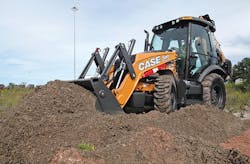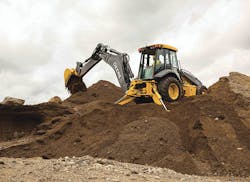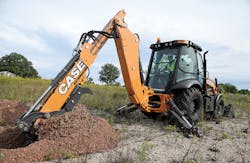If you want to start a debate, just ask what is the “Swiss Army knife” of the industry’s equipment fleet. Answers will range from skid steer to excavator to backhoe. Making the case for the backhoe, Brian Hennings, product marketing manager, backhoes and tractor loaders, for John Deere Construction and Forestry, praises their ability to dig, lift, and carry. “It’s that one machine that can do multiple jobs.” He views it almost as two machines in one, combining the best of an excavator and a wheel loader in one machine.
This is one reason it’s popular with utility contractors. It brings versatility to the job site with its ability to trench, dig around utilities, and load trucks, Hennings points out. That versatility adds value. “Backhoes continue to be one of the most versatile tractors on the job site. [They] combine an excavator and loader into one machine that can be self-transported from job site to job site. Various types of buckets, couplers, and attachments (breakers, thumbs, sweepers, snow pushers, plate compactors, and augers) continue to make it a multi-functional tool that quickly gets the job done.”
Going one step further, Jeff Jacobsmeyer, product manager for excavators, wheel loaders, and TLBs at Kubota, considers Kubota’s TLB series “essentially three machines in one.” He says it features true workhorse capabilities and is capable of performing front loader, backhoe, and tractor work.
“Kubota’s L47 and M62 tractor-loader-backhoes are an attractive three-in-one option to buyers in the rental, construction, and landscaping sectors,” continues Jacobsmeyer. The Kubota L47 and the M62 TLB are designed to meet the needs of the construction, landscaping, and rental sectors. More powerful than their predecessors and supported by an integrated main frame for increased durability, they can perform front loading, rear excavating, and other tasks. An optional mechanical two-lever quick coupler or an optional hydraulic quick coupler, available on both models, enables easy attachment and detachment of auxiliary implements, such as a pallet fork or a box blade.
The M62 has a 14-foot maximum digging depth, a 17% improvement over the previous model. In addition to the quick coupler system for a fast exchange of buckets, the backhoe features a four-point rear-mounting system that allows it to be easily removed and reattached.
Versatility
All models of Kubota’s TLB line have the versatility of removing the backhoe and installing a three-point hitch option. This three-point hitch will allow the use of any type of three-point mounted equipment commonly used on tractors today—such as a box blade, angle blade, or mower—that can be operated from the rear of the tractor.
“The new TLBs are not the same as the last generation,” states Jacobsmeyer. The new models now feature the ability to utilize certain Kubota mini excavator buckets, which can provide more versatility on the job site.
Along with a productive front loader and powerful tractor, Kubota’s M62 TLB features highly efficient backhoes that dig deeper and reach farther than previous models, with a 14-foot digging depth—a 17% improvement over the previous generation’s 12-foot maximum depth—and a bucket digging force of 6,572 pounds. The L47 boasts a 10-foot digging depth and a bucket digging force of 5,825 pounds.
On both TLB models, a lever-engaged backhoe crawling mode allows the operator to slowly creep forward or backward while remaining at the backhoe controls, saving time and enabling the more sure-footed operation that is needed when working alongside a trench.
Tech
Technology contributes to versatility but also to efficiency and productivity. Full-size backhoe loaders from JCB are now equipped with JCB AutoMATE, which provides a suite of automated features designed to improve the usability, productivity and fuel efficiency of the machine. In all, there are up to eight different features, depending on the machine model. “Not all automated features are available on all models,” explains Diego Butzke, product manager for backhoe loaders. “Some of the automated features are dependent on specific features, like joystick controls, for example.”
One of JCB’s suite of automated features is AutoCHECK. “You turn the key on and within three seconds, it reads all under-the-hood daily checkpoints,” explains Butzke. “It’s efficient for daily checks and maintenance because it provides early access to machine problems. Operators have a hard time keeping up with daily checks. AutoCHECK displays any problems that need the attention of the operator and sends the information via JCB’s LiveLink telematics system, so you know what’s going on at that moment, for example, if there’s water in the fuel or if you need to change the filters or add fluids….” It helps prevent unscheduled downtime.
JCB’s AutoSTABILIZERSUP can raise the stabilizer legs automatically, which saves time. AutoDRIVE holds the engine RPMs constant to maintain machine speed while driving, like cruise control on a car. This allows operators to pay more attention to traffic, and what’s around them. Not only is it a safety feature, but it also enhances productivity.
Other technological advances to increase productivity include tilt rotators. “There are tilt rotators you can install on backhoes,” says Butzke, to allow the operator to swing and rotate the bucket to smooth and contour a ground surface, or to use a grabber to pick up logs and rocks very precisely. “It provides flexibility, dexterity, and precision.”
Deere Tech
The latest technology incorporated into John Deere L-Series backhoes allows operators to be more productive and efficient than ever before, says Hennings. Thanks to auto ride control, the front loader acts almost like a shock absorber, smoothing out travel during load-and-carry tasks and helping full loads reach their destination. The auto-shift transmission option selects the right gear for the job, which is especially operator-friendly when using the machine in urban areas and can contribute to better fuel efficiency.
Rear backhoe lifting and craning activities with the John Deere machines can be boosted by Lift Mode, Hennings indicates. “At the push of a button, the 310SL HL, 410L, and 710L enable operators to increase lift capacity by 10 to 15% when needed, minimizing the need to reposition or reconnect to a different machine.”
The design of the John Deere backhoe allows an operator to quickly switch out various rear hydraulic attachments such as breakers, augers, and plate compactors and select the proper GPM (gallons per minute) flow from the monitor inside the cab.
Advanced technology makes operators more efficient, but also assists maintenance. JDLink’s machine monitoring provides real-time utilization of data and alerts to help minimize downtime.
In addition, some technical innovations help the operator when he’s out of the cab. Some of the more unusual backhoe jobs are accomplished from outside the operator’s seat. For example, hand-held hydraulic tools can be attached to the backhoe’s hydraulic system for additional job site versatility, such as jackhammers used in very tight or remote spaces or sump pumps needed to drain diked or pooled water.
A CASE of Technology
For 2019, CASE Construction Equipment has introduced some technological updates to its N Series backhoe loaders that are designed to assist operators in tough conditions. Primary among them is an industry-exclusive new feature called PowerBoost—a new button on the left-hand joystick that provides a momentary boost of increased hydraulic power without decreasing engine revolutions per minute. “It’s a momentary button the operator presses for four seconds of increased force to dig through tough ground such as clay, rocks, frost, hard pack, or tree roots,” explains Ed Brenton, product marketing manager. This enables the operator to get through difficult ground conditions quickly, with fewer passes and using less fuel.
Similar to PowerBoost is another new feature called PowerLift. This button “stays on as long as you want,” says Brenton, providing increased force and lifting comparable with some mid-sized excavators at lower engine revolutions per minute for powerful yet smooth lifting and craning operations. “It’s not just for digging. You can use it for lifting and placing concrete structures like pipe and septic tanks, and you can use it in frost, rock, clay, or when you need extra power and force. It lowers the engine revolutions per minute to 1400 for more control while it increases force and lifting.”
Brenton explains that there is also an “ECO mode” to assist in operating at peak efficiency. “You lose speed, but not power,” he explains. “It’s a way of using the engine as efficiently as possible. It saves fuel, maintenance, and wear and tear.”
Additional updates for the 2019 N Series backhoe include PowerDrive upgrades, namely, DirectDrive, a new feature on CASE S-Type and H-Type transmissions that engages the engine and transmission directly for improved gradeability, faster road speeds, improved fuel economy, and faster travel times around the job site and between jobs. The PowerDrive transmission maintains the existing auto shift feature and now includes an automated activation of the direct drive feature in third and fourth gears, based on torque demand and conditions on the job site. “It’s making four gears act like six speeds,” elaborates Brenton. “It physically engages the engine and transmission for more power and torque without bogging down or having to down-shift on hills.” Horsepower on the 580SN Wide Track model has increased to 110 horsepower (hp) for improved acceleration and gradeability.
A new factory-installed hydraulic thumb is available on all extend-a-hoe models for more versatile operation. This new thumb improves material handling performance and is compatible with either a mechanical or hydraulic bucket coupler, allowing the operator to change buckets and attachments without affecting the thumb installation.
CASE’s N Series backhoes feature new loader control functions. The loader joystick features three new switches that will simplify operation and make it more intuitive. A new declutch trigger on the back of the joystick simplifies operation during continuous or repetitive operations, such as loading trucks. A new roller/rocker switch with a detent position can be locked in the forward position for better attachment control with attachments such as brooms and snow blowers. An all-new F-N-R switch simplifies operation by allowing for quick and easy directional changes without taking a hand off the joystick.
Newly enhanced roller switches for auxiliary and extend-a-hoe control have been added to the backhoe pilot control joysticks for intuitive control and improved metering. In addition, CASE improved the seat design with a new premium heated, air suspension seat option. A hands-free, Bluetooth radio has also been added to allow operators to safely use the phone and stream a broader spectrum of music.
Operator comfort provides a known increase in productivity. CASE’s other new features are designed to save time, fuel, labor, maintenance, and wear and tear on the machine—all of which contribute to improving productivity, a common customer demand.
Customers also want more power in a compact machine, Brenton acknowledges. “Big, bulky machines are slower and cost more. Customers want the versatility of a smaller machine.”
Small Trends
Two-thirds of all machines sold are compact, Butzke says. “There’s a need for small machines due to tighter work sites, so we’re reducing the size of our backhoes…but not the performance.”
JCB’s 3CX COMPACT backhoe is 35% smaller but provides similar capability as a full-size machine. Designed for working in confined spaces, it has a dig depth of 14 feet 3 inches and a tight turning radius, which, combined with switchable two-wheel and four-wheel steering modes, allows it to work inside a single lane on a highway. That makes it particularly useful for utilities work. “A full-size backhoe needs two lanes to work,” says Butzke. “The 3CX COMPACT closes only one lane. That keeps traffic flowing.”
Featuring a side-shift chassis that enables it to work close to walls and fences, the 3CX COMPACT can work in job sites with limited space. “It goes anywhere,” says Butzke.
Their new model is the size of a track loader and is touted as providing “skid steer and excavator performance in one package.” One of the smallest backhoe loaders, the 1CXT is now on tracks. That means less ground damage, better climbing, increased pushing power, better stability, and improved performance on soft ground. (JCB stopped selling the wheeled version in 2010.)
“It’s a backhoe loader on tracks,” confirms Butzke, “with a lot of pushing power and flotation.” Like its larger counterpart, it has a side-shift chassis for working in tight spaces. Its dig depth is 10 feet 1 inch.
“You can take them anywhere,” insists Butzke. “They’re good for landscaping, utilities, and cemeteries. Cemeteries are always expanding and putting graves closer together. This is one machine that does the work of two; it’s got a track loader front end with a mini-excavator back end.” He says pre-sales have been good. “It’s small, versatile, and powerful.”
However, not all customers need a small machine; instead, they might need power. That’s why JCB designed the 4CX SUPER backhoe in 1991 that is the size of a small wheel loader. “It has more pushing power because of its large wheels,” explains Butzke. In fact, he says it was the baseline for the military backhoe—the HMEE. Originally built for the US Army and NATO-aligned forces, it’s “war-proof,” he says, with a high level of protection, good flotation on any terrain, and the ability to reach convoy speeds of 60 miles per hour.
Backing the Backhoe
The backhoe is one of the most used pieces of heavy construction equipment. Why a backhoe instead of an excavator? Versatility and productivity.
With a boom, stick, and bucket on the rear, the backhoe can complete most of the same digging jobs an excavator can. But with a bucket in the front, backhoes can also move large amounts of material.
Backhoes are faster, with speeds up to 25 mph, and because they’re on tires, they have more mobility to go virtually anywhere on the job site.
Ideal for construction, demolition, moving material, digging and excavating, landscaping, breaking up asphalt, and more, the backhoe has proven itself an indisputable asset to a construction fleet.






